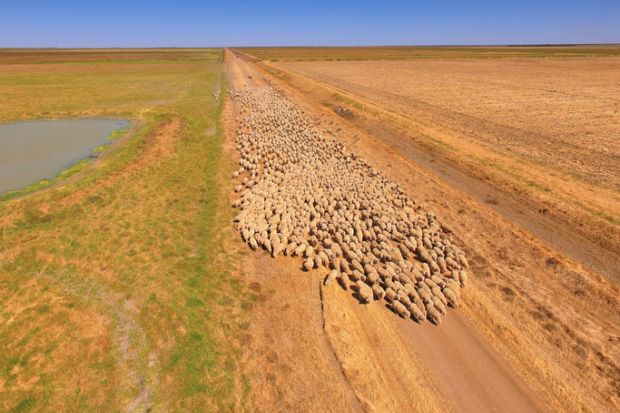A deal between Australia’s biggest regional university and the federal agricultural agency could see the two organisations borrowing each other’s staff, in a research-driven quest to boost farm exports and avert a flight from country towns.
The “strategic partnership” between Charles Sturt University (CSU) and the Department of Agriculture, Water and the Environment (DAWE), signed in December, is also designed to thwart outbreaks in the biosphere and cybersphere.
CSU’s acting vice-chancellor, John Germov, said details of the agreement would be fleshed out in the coming months. But it would involve seconding university staff to work on the department’s projects and “vice versa”.
CSU also proposes a cadetship programme for its Aboriginal students, giving them “valuable work experience” while helping the department boost its indigenous staff numbers.
Professor Germov said CSU’s agricultural research capabilities, its footprint across six regional campuses and its “connections to primary producers” would help the department test and develop its policies.
“We mightn’t be as big as some of the other players in the sector but our research, predominantly, is applied research dealing with real-world problems,” he said.
The partnership will focus on new crop strains and sustainable management practices to preserve land and water resources. Professor Germov said the agreement would also bolster the department’s biosecurity activities and the security of its “massive” databases.
“It’s a huge department. They’re dealing with big data and how to ensure that it’s secure and analysed effectively to support evidence-based decision-making.”
The data load has snowballed partly because of the creeping automation of agriculture, as farmers harness robotics and online sensors that monitor crop development, nutrients and moisture levels. “Ag-tech is going to be a huge growth industry,” Professor Germov said.
“While we might see manual tasks declining on the farms, there will be this other industry developing in how to use the data to inform effective land- and water-management practices.”
By imparting such technological skills, universities can boost agricultural profitability while averting the long-feared desertion of country towns, as rural workers displaced by farm mechanisation decamp for the cities.
DAWE wants to increase Australia’s agricultural output to A$100 billion (£57 billion) by 2030, up from about A$61 billion at present. “You can’t do that without strengthening those regional communities,” Professor Germov said.
He said there were already signs of growth in “mid-sized” regional towns such as Orange, Bathurst and Wagga Wagga, where CSU has campuses. The movement to such places has accelerated during the pandemic, as workers embrace the potential of remote work.
Similar influxes are occurring in Victorian regional centres like Ballarat, where Federation University is based. While this increases local demand for higher education, Federation vice-chancellor Duncan Bentley said the demand must be addressed thoughtfully.
He said the traditional approach – establish a regional campus and “stick in a few courses” – often ended in closure once latent demand had been absorbed. “For regional areas, the big issue is [to] respond to the needs of the community. Don’t think of the university – think of what the community needs.”
That philosophy guided Federation’s December agreement with the rural council at Ararat, about 100 kilometres from Ballarat, to “reactivate” the university’s local campus – which it withdrew from last decade – as a centre for advanced agricultural research. Professor Bentley said he hoped to develop dozens of similar partnerships across regional Victoria.
He said the Ararat centre would initially house four council-employed economic development and project management staff. Dozens of academics and PhD students could work with them, researching the “fundamental agricultural priorities” of an area that typically produces raw food and fibre and leaves more profitable production stages to others.
Research areas would include “smart farming” technologies such as drones, robotics and sensors, including producing them locally through 3D printing and advanced manufacturing techniques. Researchers would also look at the viability of new product lines like flatbread and game meat, and “circular economy” approaches such as reusing farm waste to generate energy.
The aim was to replicate the success of top overseas agricultural exporters. Professor Bentley said the Netherlands, with around nine times Ararat’s farmland, produced 878 times the export value.
Register to continue
Why register?
- Registration is free and only takes a moment
- Once registered, you can read 3 articles a month
- Sign up for our newsletter
Subscribe
Or subscribe for unlimited access to:
- Unlimited access to news, views, insights & reviews
- Digital editions
- Digital access to THE’s university and college rankings analysis
Already registered or a current subscriber? Login











